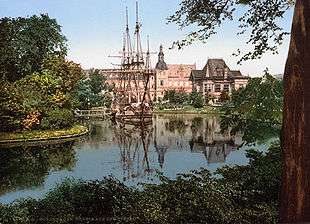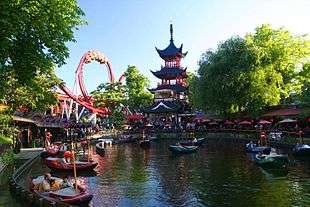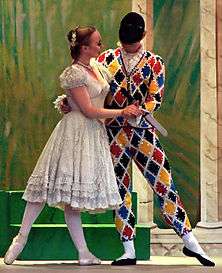Tivoli Gardens
|
The entrance to Tivoli, illuminated at night | |
| Location | Copenhagen, Denmark |
|---|---|
| Coordinates | 55°40′25″N 12°34′06″E / 55.67361°N 12.56833°ECoordinates: 55°40′25″N 12°34′06″E / 55.67361°N 12.56833°E |
| Owner | Tivoli A/S |
| Operated by | Tivoli A/S |
| General Manager | Lars Liebst |
| Opened | 1843 |
| Visitors per annum | 4,733,000 in 2015[1] |
| Area | 82,717 square metres (20 acres) |
| Rides | |
| Total | 27[2] |
| Roller coasters | 4 |
| Website | Tivoli.dk |
Tivoli Gardens (or simply Tivoli) is a famous amusement park and pleasure garden in Copenhagen, Denmark. The park opened on 15 August 1843 and is the second-oldest operating amusement park in the world,[3] after Dyrehavsbakken in nearby Klampenborg, also in Denmark.
With 4.733 million visitors in 2015,[1] Tivoli is the second-most popular seasonal theme park in the world, the most-visited theme park in Scandinavia and the fourth most-visited in Europe, only behind Disneyland Paris, Europa-Park Rust and the Efteling.
History
The amusement park was first called "Tivoli & Vauxhall";[4] "Tivoli" alluding to the Jardin de Tivoli in Paris (which in its turn had been named from Tivoli near Rome, Italy),"Vauxhall" alluding to the Vauxhall Gardens in London. It is also mentioned in various books, like Number the Stars by Lois Lowry.
Tivoli's founder, Georg Carstensen (b. 1812 – d. 1857), obtained a five-year charter to create Tivoli by telling King Christian VIII that "when the people are amusing themselves, they do not think about politics". The monarch granted Carstensen use of roughly 15 acres (61,000 m²) of the fortified glacis outside Vesterport (the West Gate) for an annual rent. Therefore, until the 1850s, Tivoli was outside the city, accessible through Vesterport.
From the very start, Tivoli included a variety of attractions: buildings in the exotic style of an imaginary Orient: a theatre, band stands, restaurants and cafés, flower gardens, and mechanical amusement rides such as a merry-go-round and a primitive scenic railway. After dark, colored lamps illuminated the gardens. On certain evenings, specially designed fireworks could be seen reflected in Tivoli's lake.
Composer Hans Christian Lumbye (b. 1810 – d. 1874) was Tivoli's musical director from 1843 to 1872. Lumbye was inspired by Viennese waltz composers like the Strauss family (Johann Strauss I and his sons), and became known as the "Strauss of the North." Many of his compositions are specifically inspired by the gardens, including "Salute to the Ticket Holders of Tivoli", "Carnival Joys" and "A Festive Night at Tivoli". The Tivoli Symphony Orchestra still performs many of his works.

In 1874, Chinese style Pantomimeteatret (The Pantomime Theatre) took the place of an older smaller theatre. The audience stands in the open, the stage being inside the building. The theatre's "curtain" is a mechanical peacock's tail. From the very beginning, the theatre was the home of Italian pantomimes, introduced in Denmark by the Italian Giuseppe Casorti. This tradition, which is dependent on the Italian Commedia dell'Arte has been kept alive, including the characters Cassander (the old father), Columbine (his beautiful daughter), Harlequin (her lover), and, especially popular with the youngest spectators, the stupid servant Pierrot. The absence of spoken dialogue is an advantage, as Tivoli is now an international tourist attraction.
In the late 19th and early 20th century, Tivoli also hosted human exhibitions.[5]
In 1943, Nazi sympathisers burnt many of Tivoli's buildings, including the concert hall, to the ground. Temporary buildings were constructed in their place and the park was back in operation after a few weeks.
Tivoli is always evolving without abandoning its original charm or traditions. As Georg Carstensen said in 1844, "Tivoli will never, so to speak, be finished," a sentiment echoed just over a century later when Walt Disney said of his own Tivoli-inspired theme park, "Disneyland will never be completed. It will continue to grow as long as there is imagination left in the world." In Swedish, tivoli has become synonymous with any amusement park.
Rides

The park is best known for its wooden roller coaster, Rutschebanen, or as some people call it, Bjergbanen (the Mountain Coaster), built in 1914. It is one of world's oldest wooden roller coasters that is still operating today. An operator controls the ride by braking down the hills so it won't gain too much speed. It is an ACE Coaster Classic.[6]
Another roller coaster, Dæmonen (The Demon), features an Immelmann loop, a loop, and a zero-G roll all during the ride time of just one minute and forty six seconds. An old roller coaster, Slangen, was removed to have enough space for The Demon. Dæmonen is situated next to the concert hall.
The world's second tallest carousel, The Star Flyer, opened in Tivoli in 2006. Eighty meters high and built by the Austrian company Funtime, it offers panoramic views of the city.[4]
On 1 May 2009, Tivoli opened the new ride Vertigo, a looping plane ride where the rider pilots the ride, able to control the plane.
The newest ride, Aquila, opened on 11 April 2013. It is a giant swing and spinner with centrifugal powers up to 4 G, named after the constellation of the Eagle.[7]
Roller coasters
| Ride name | Type | Opened in | Manufacturer | Additional information |
|---|---|---|---|---|
| Karavanen (Caravan) | steel sit down | 1974 | Zierer | Reaches a speed of 16 mph (26 km/h) on a 198 ft long track (60m) and a height of 11 ft (3.4 m); age limit 2 years old. Small Tivoli model, train 2x6. |
| Dæmonen (The Demon) | floorless steel sit down | 2004 | Bolliger & Mabillard | Reaches a speed of 48 mph (77 km/h) on a 1,851 ft long track (564m) and a height of 92 ft (28 m) with 3 inversions (loop, Immelmann, zero g-roll); height limit 1,32m. Floorless Custom Coaster, train 4x6. |
| Odinexpressen (Odin Express) | powered coaster | 1985 | Mack Rides | Reaches a speed of 37 mph (60 km/h) on a 984 ft long track (300m); age limit 2 years old. Custom Powered Coaster, train 2x10. |
| Rutschebanen (The Roller Coaster) | wooden sit down | 1914 | LaMarcus Thompson | This classic coaster reaches a speed of 31 mph (50 km/h) on a 2362 ft long track (720m) and a height of 43 ft (13 m). Themed around a mountain, train 2x12. |
Other rides
- Aquila - giant swing and spinner ride that opened in 2013; with centrifugal powers up to 4G; height limit 1,2m.
- Bumper Cars - classic bumper cars that date from 1926.
- The Dragon (Removed)- giant swing / flic flac ride that opened in 1995; height limit 1,4m. Huss.
- Ballongyngen - Ferris wheel which opened during WWII in 1943.
- The Flying Trunk - a 7-minute H.C. Andersen-inspired dark ride that opened in 1993 and was renovated in 2010. Mack Rides.
- Galley Ships - roundabout boats that opened in 1937.
- The Golden Tower - drop tower that opened in 1999; height limit 1,4m. S&S Worldwide.
- The Mine - dark ride in a boat that opened in 2003; this 200 meters long mine-themed ride has a 2m drop. Mack Rides.
- The Monsoon - giant swing, a magic carpet ride that opened in 2001; height limit 1,4. Zierer.
- Spinning Top - breakdance spinner that opened in 1988; height limit 1,3m. Huss.
- Star Flyer (Himmelskibet) - an 80 m tall sky flyer that opened in 2006; height limit 1,2m. Funtime.
- Vertigo giant swing that opened in 2009; height limit 1,4m. Technical Park. This looping plane ride reaches a speed of 60 mph (100 km) and a height of 30 meters.
Kiddie rides
- The Big Clock (Den blå Safir) - mini Ferris wheel that opened in 1970.
- Dragon Boats - pilot your own boat on the water, opened in 1936.
- Dyrekarussellen - classic carousel ride from 1920.
- The Fun House - house of fun.
- The Light House - air carousel that opened in 2010.
- The Little Pilot - airplanes that opened in 1990.
- Nautilus - roundabout boats that opened in 2007.
- Petzi's World - play ground for kids.
- The Panda - mini drop tower that opened in 2000. Zamperla.
- Rasmus Klump - play and picnic area.
- The Temple Tower pull yourself up tower ride that opened in 2000. Heege.
- Trolley Bus - crazy bus. Zamperla.
- Vintage Cars - on track cars that opened in 1959.
Other attractions
- The Pantomime Theater has free pantomime shows.
- The Tivoli Guard Boys stars boys age 9 - 16 who perform music at the park.
- Tivoli Aquarium - located below ground level inside The Concert Hall, entrance is at extra charge.
- Amusement Arcades - extra charge.
- Tivoli Jackpot - cash prizes, extra charge.
- Tivoli Festival - takes place from 14 May to 8 September and features more than 50 different events that include opera shows, symphony concerts, chamber music, pop and rock artists, and much more. On Fridays at 10 pm there is a weekly rock concert under the banner Friday Rock.
- The Concert Hall - there has been a concert hall at the park since day one; the current concert hall was built in 1956 and seats 1660 guests. It was renovated in 1985 and the Rotunda was added then. Extra charge music concerts and shows.
- The Glass Hall Theater - the current Glass Hall was built in 1946, following the destruction of the old one in 1944 during the Nazi occupation of Denmark. the hall features all kinds of music events as well as theater shows for kids. Extra charge.
- The Harmony Pavilion - occasionally music performances throughout the year and special events.
- Open Air Stage - this open-air stage hosts both music performances and other kind of shows.
- Promenade Pavilion - occasionally music performances throughout the year and special events.
In addition, there is a Halloween Fest in October and Christmas Holidays in December. During the summer the park has fireworks shows.
Hotels
There is one on-site hotel at the park: Hotel Nimb. The Tivoli Hotel & Congress Centre is affiliated with Tivoli Gardens only by name, but close cooperation does take place.
Performing arts
Besides the rides, Tivoli Gardens also serve as a venue for various performing arts & as an active part of the cultural scene in Copenhagen.
Tivolis Koncertsal
Tivolis Koncertsal is a classical concert hall featuring concerts with some of the largest names in international classical music.
The Pantomime Theatre

The Pantomime Theatre is an open-air theatre designed by Vilhelm Dahlerup, also known for the design of the Royal Danish Theatre. It is a toy-like historicist built in Chinese style and noted for its mechanical front curtain that takes five men to operate and unfolds like a peacock's tail. As indicated by the name, it is primarily a scene for pantomime theatre in the classical Italian commedia dell'arte tradition, which is performed daily with a live pit orchestra. Besides this original function, the theatre leads a second life as a venue for ballet and modern dance, performing works by choreographers such as August Bournonville, Dinna Bjørn, Louise Midjord and Paul James Rooney.
The Tivoli Youth Guard
The Tivoli Youth Guard is a formation of boys and girls aged 8–16 dressed in uniforms reminiscent of those of the Royal Danish Guard complete with bearskins. It was founded in 1844 and gives concerts, makes parades, stands guard at the garden's buildings and monuments at special occasions and represents the gardens at various events. It is composed of a Corps of drums, a military styled marching band and a honor guard platoon.
Rhythmical music
During the warmer summer months, Tivoli also features a live music series dubbed Fredagsrock (Friday Rock), which in the past has featured Roxette, the Smashing Pumpkins, Sting, the Beach Boys, Pet Shop Boys, Kanye West and popular Danish groups such as TV-2, Nephew, Hanne Boel, Raveonettes and Thomas Helmig.
During Copenhagen Jazz Festival Tivoli Gardens is one of the many Copenhagen localities that serves as a venue for concerts.[8]
Gallery
 The H.C. Andersen castle
The H.C. Andersen castle A view of the illuminated gardens on a December night
A view of the illuminated gardens on a December night Tivoli Gardens lake tree
Tivoli Gardens lake tree- The Vaffelbageriet in Tivoli at night
 The Japanese Tower at night
The Japanese Tower at night Tivoli Gardens Japanese tower and boating lake
Tivoli Gardens Japanese tower and boating lake The Pantomime Theatre
The Pantomime Theatre Tivoli Gardens seen from a birds eye view in 2015
Tivoli Gardens seen from a birds eye view in 2015 The Glass Hall
The Glass Hall Tivoli's Moorish Palace, the Nimb Hotel and Restaurant
Tivoli's Moorish Palace, the Nimb Hotel and Restaurant Aerial photography, taken from Eduard Spelterini's balloon on 22 June 1922
Aerial photography, taken from Eduard Spelterini's balloon on 22 June 1922
See also
References
- 1 2 "TEA/AECOM 2015 Global Attractions Attendance Report Report" (PDF). Themed Entertainment Association. 2016. Retrieved June 3, 2016.
- ↑ "Rides". Tivoli.dk. Retrieved 20 June 2013.
- ↑ "Top attractions in Denmark". visitdenmark.com. Visit Denmark. Retrieved 8 April 2016.
- 1 2 Tivoli – Tivoli Gardens Copenhagen – Copenhagen Portal – Tourist Guide. Copenhagenet.dk. Retrieved on 15 August 2011.
- ↑ Andreassen, Rikke (2015). Human Exhibitions. Race, Gender and Sexuality in Ethnic Displays. Farnham: Ashgate. pp. 13–15. ISBN 9781472422453.
- ↑ ACE Coaster Classic Awards. Aceonline.org. Retrieved on 15 August 2011.
- ↑ Aquila. Tivoli.dk. Retrieved 27 December 2013.
- ↑ Tivoli summer 2008. Tivoli.dk (29 June 2009). Retrieved on 15 August 2011.
External links
| Wikimedia Commons has media related to Tivoli Gardens, Copenhagen. |
- Official website (Danish)
- Official website (English)
- Copenhagen-Portal – Tivoli and History
- The Roller Coaster Database's page about Tivoli
- Tivoli Gardens Article
- Picture gallery including Tivoli's first Halloween season
